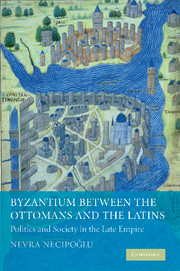Book contents
- Frontmatter
- Contents
- List of maps
- Acknowledgements
- Note on transliteration
- List of abbreviations
- Map 1 The Byzantine world in the fourteenth–fifteenth centuries
- Map 2 Byzantium and its neighbors, c. 1350
- Map 3 Byzantium and its neighbors after 1402
- PART I INTRODUCTION AND POLITICAL SETTING
- PART II THESSALONIKE
- PART III CONSTANTINOPLE
- PART IV THE DESPOTATE OF THE MOREA
- Conclusion
- Appendix I Archontes of Thessalonike (fourteenth—fifteenth centuries)
- Appendix II “Nobles” and “small nobles” of Thessalonike (1425)
- Appendix III Constantinopolitan merchants in Badoer's account book (1436–1440)
- Appendix IV Members of the Senate of Constantinople cited in the synodal tome of August 1409
- Appendix V Some Greek refugees in Italian territories after 1453
- Bibliography
- Index
Conclusion
Published online by Cambridge University Press: 07 December 2009
- Frontmatter
- Contents
- List of maps
- Acknowledgements
- Note on transliteration
- List of abbreviations
- Map 1 The Byzantine world in the fourteenth–fifteenth centuries
- Map 2 Byzantium and its neighbors, c. 1350
- Map 3 Byzantium and its neighbors after 1402
- PART I INTRODUCTION AND POLITICAL SETTING
- PART II THESSALONIKE
- PART III CONSTANTINOPLE
- PART IV THE DESPOTATE OF THE MOREA
- Conclusion
- Appendix I Archontes of Thessalonike (fourteenth—fifteenth centuries)
- Appendix II “Nobles” and “small nobles” of Thessalonike (1425)
- Appendix III Constantinopolitan merchants in Badoer's account book (1436–1440)
- Appendix IV Members of the Senate of Constantinople cited in the synodal tome of August 1409
- Appendix V Some Greek refugees in Italian territories after 1453
- Bibliography
- Index
Summary
COMMON PATTERNS AND DIVERGENCES: ASSESSING THE INTERREGIONAL SIMILARITIES AND VARIATIONS
Having examined and analyzed the effects of Ottoman pressures between about 1370 and 1460 in three major areas of the Byzantine Empire in terms of the political attitudes that emerged among various groups or individuals, we can detect certain patterns that recur in Thessalonike and Constantinople, and to some degree in the Morea as well. First, it has been seen that variations in the political orientation of different groups within the empire's population towards foreign powers were closely intertwined with the social tensions that existed in Byzantium during this period, which resulted in marked differences between the attitudes of people belonging to the upper and the lower segments of Byzantine society. In the two largest urban centers of the empire represented by Constantinople and Thessalonike, generally speaking, an opinion in favor of cooperation with western Christian powers against the Ottomans prevailed among the aristocracy. Included within the ranks of this urban aristocracy were the ruling and intellectual elite of the cities named above, as well as rich merchants and businessmen who had strong economic ties with Italian maritime republics. In the rural areas, too, represented by the countryside of Thessalonike and the Morea, the landowning aristocrats on the whole seem to have shared the western political orientation of their urban counterparts.
- Type
- Chapter
- Information
- Byzantium between the Ottomans and the LatinsPolitics and Society in the Late Empire, pp. 285 - 290Publisher: Cambridge University PressPrint publication year: 2009



